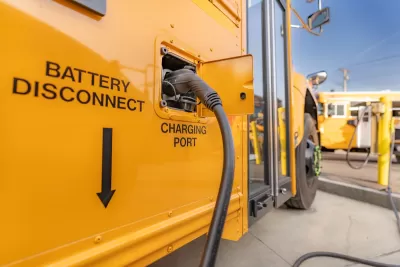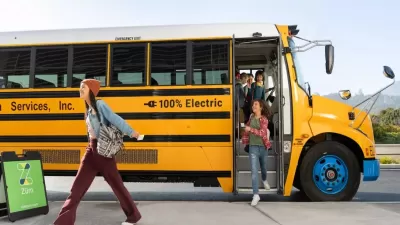Why switching school bus fleets to electric vehicles is good for students, the environment, and school districts’ finances.

In an opinion piece, former chair of the Republican National Committee Michael Steele calls for support of electrifying school bus fleets despite “claims by some in Congress that federal government support for electric school buses is a ploy to help the Chinese Communist Party (CCP).”
According to Steele, “Unsubstantiated claims about e-buses somehow helping the CCP distract from the clear advantages of modernizing our school bus infrastructure and only serve as political theater for some lawmakers to energize a certain segment of their base.”
Steele notes that his home state of Maryland is one of the nation’s leaders in buying electric school buses, with Montgomery County already operating a fleet of over 220 electric school buses.
Steele highlights the benefits of electrifying school fleets: improved health for students, reduced greenhouse gas emissions, and economic advantages. “One study found that electric buses could save between $73,000 and $173,000 per unit over their lifetimes. A Department of Energy study similarly projected hundreds of thousands of dollars’ in savings for a city that invested in four electric buses and four charging stations.”
For Steele, the health and environmental benefits are obvious and unimpeachable, while the up-front costs are offset by future savings. “An ounce of prevention is worth a pound of cure, and this one will yield us lower costs, cleaner communities and healthier kids.”
FULL STORY: Don’t Pump the Brakes on Electric School Buses

Planetizen Federal Action Tracker
A weekly monitor of how Trump’s orders and actions are impacting planners and planning in America.

DARTSpace Platform Streamlines Dallas TOD Application Process
The Dallas transit agency hopes a shorter permitting timeline will boost transit-oriented development around rail stations.

Four Reasons Urban Planners Can’t Ignore AI
It’s no longer a question of whether AI will shape planning, but how. That how is up to us.

Texas State Bills to Defund Dallas Transit Die
DART would have seen a 30% service cut, $230M annual losses had the bills survived.

Bikeshare for the Win: Team Pedals to London Cricket Match, Beats Rivals Stuck in Traffic
While their opponents sat in gridlock, England's national cricket team hopped Lime bikes, riding to a 3-0 victory.

Amtrak’s Borealis Exceeds First Year Ridership Expectations
205,800 passengers have boarded the St. Paul to Chicago line, well above initial MDOT projections.
Urban Design for Planners 1: Software Tools
This six-course series explores essential urban design concepts using open source software and equips planners with the tools they need to participate fully in the urban design process.
Planning for Universal Design
Learn the tools for implementing Universal Design in planning regulations.
City of Mt Shasta
City of Camden Redevelopment Agency
City of Astoria
Transportation Research & Education Center (TREC) at Portland State University
US High Speed Rail Association
City of Camden Redevelopment Agency
Municipality of Princeton (NJ)





























